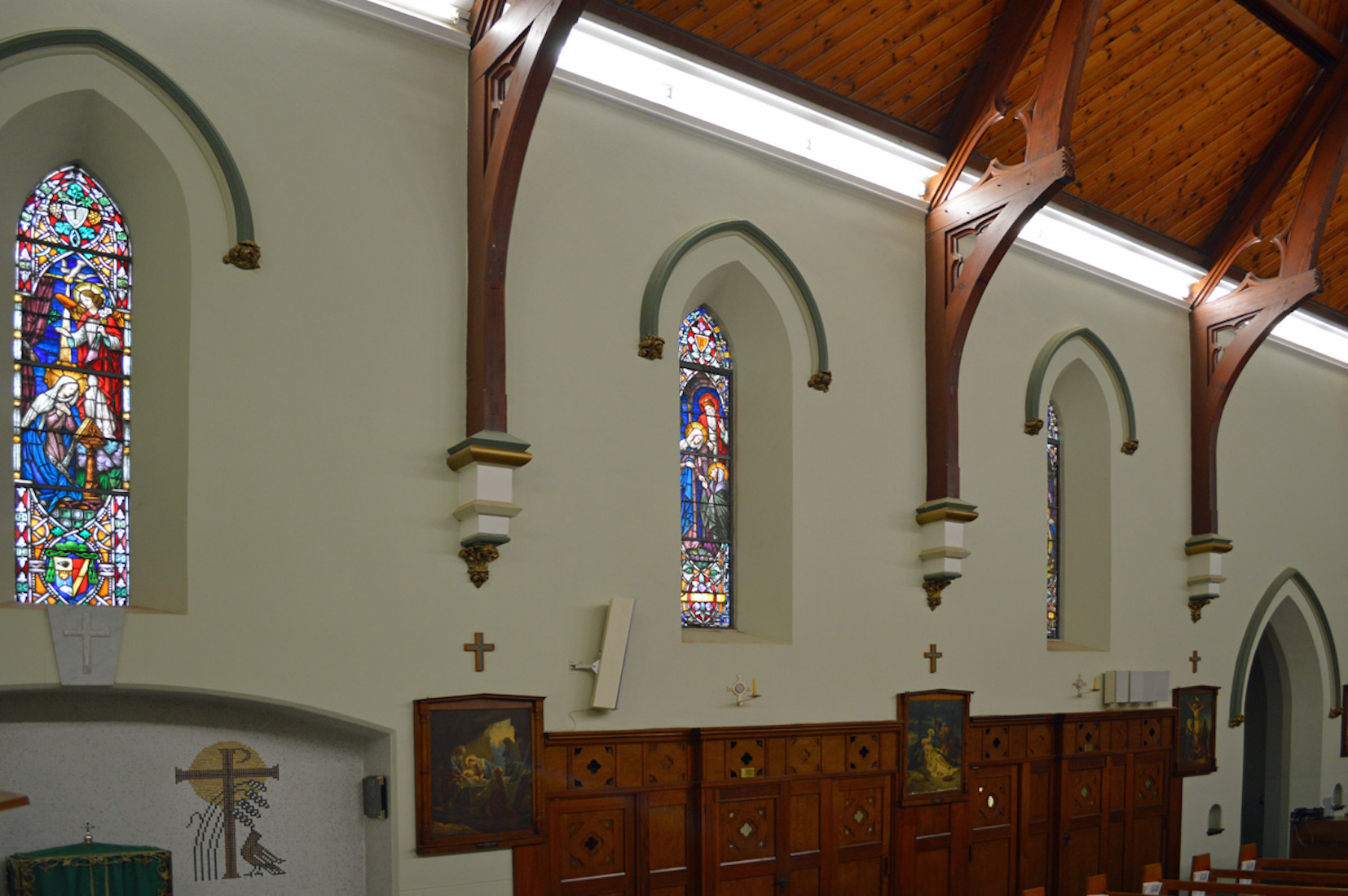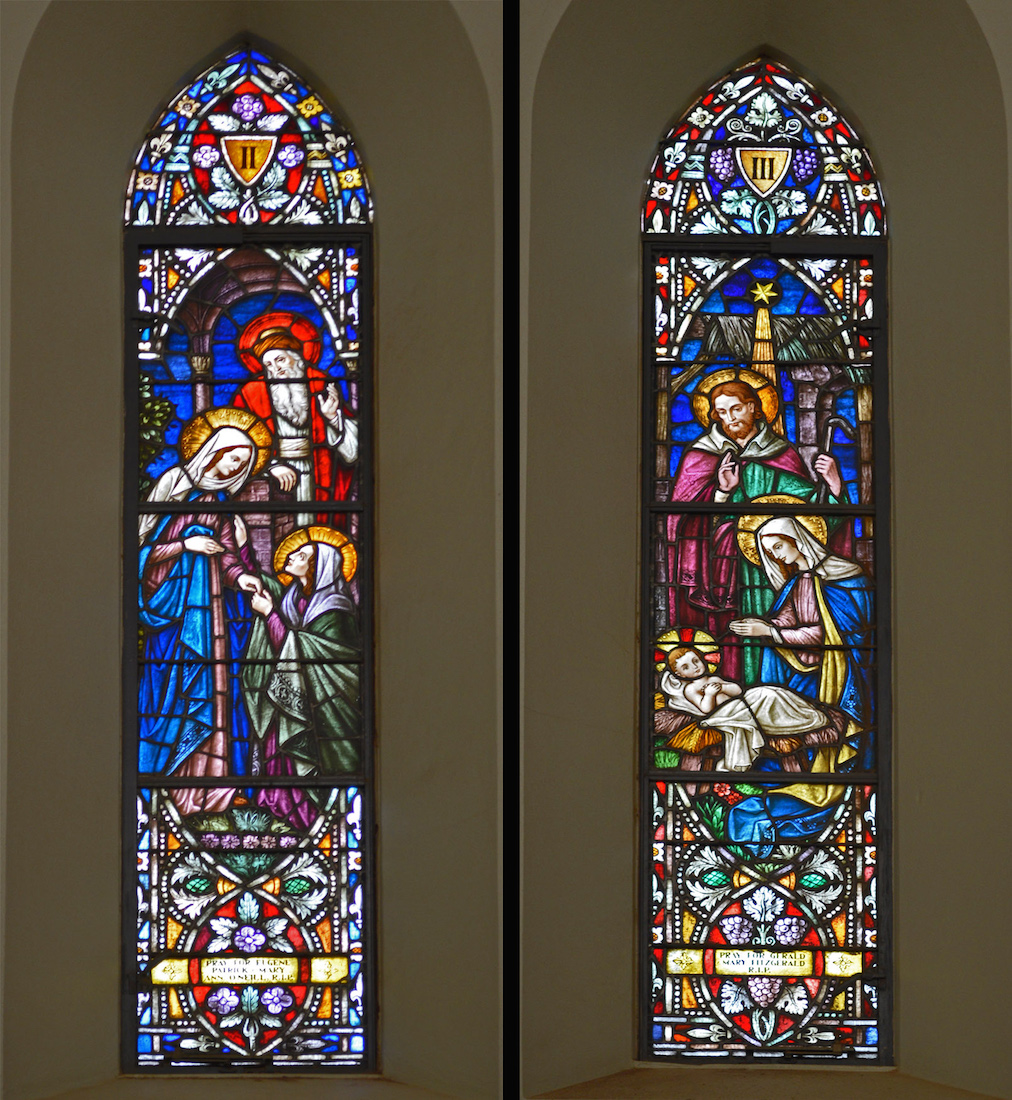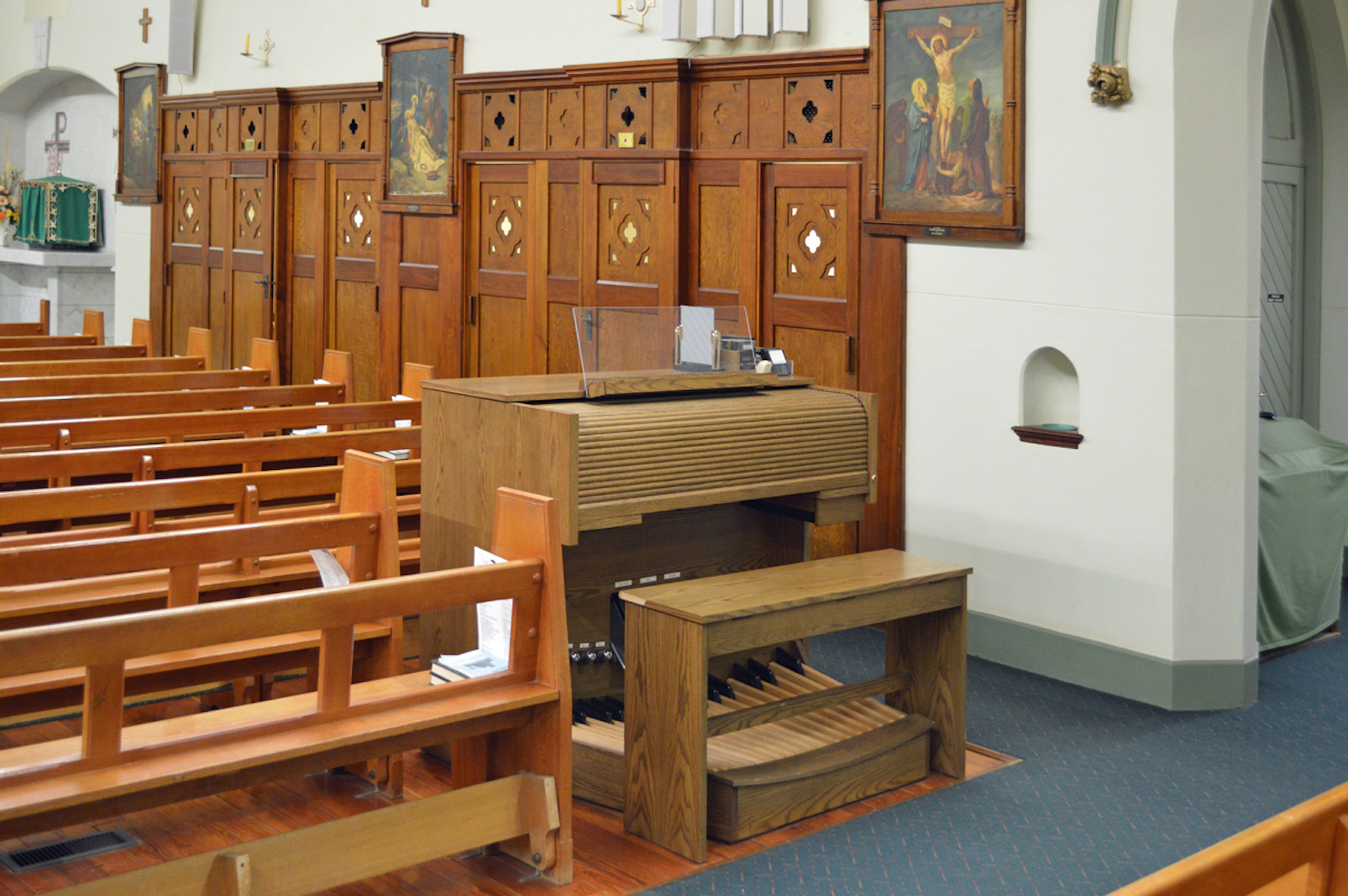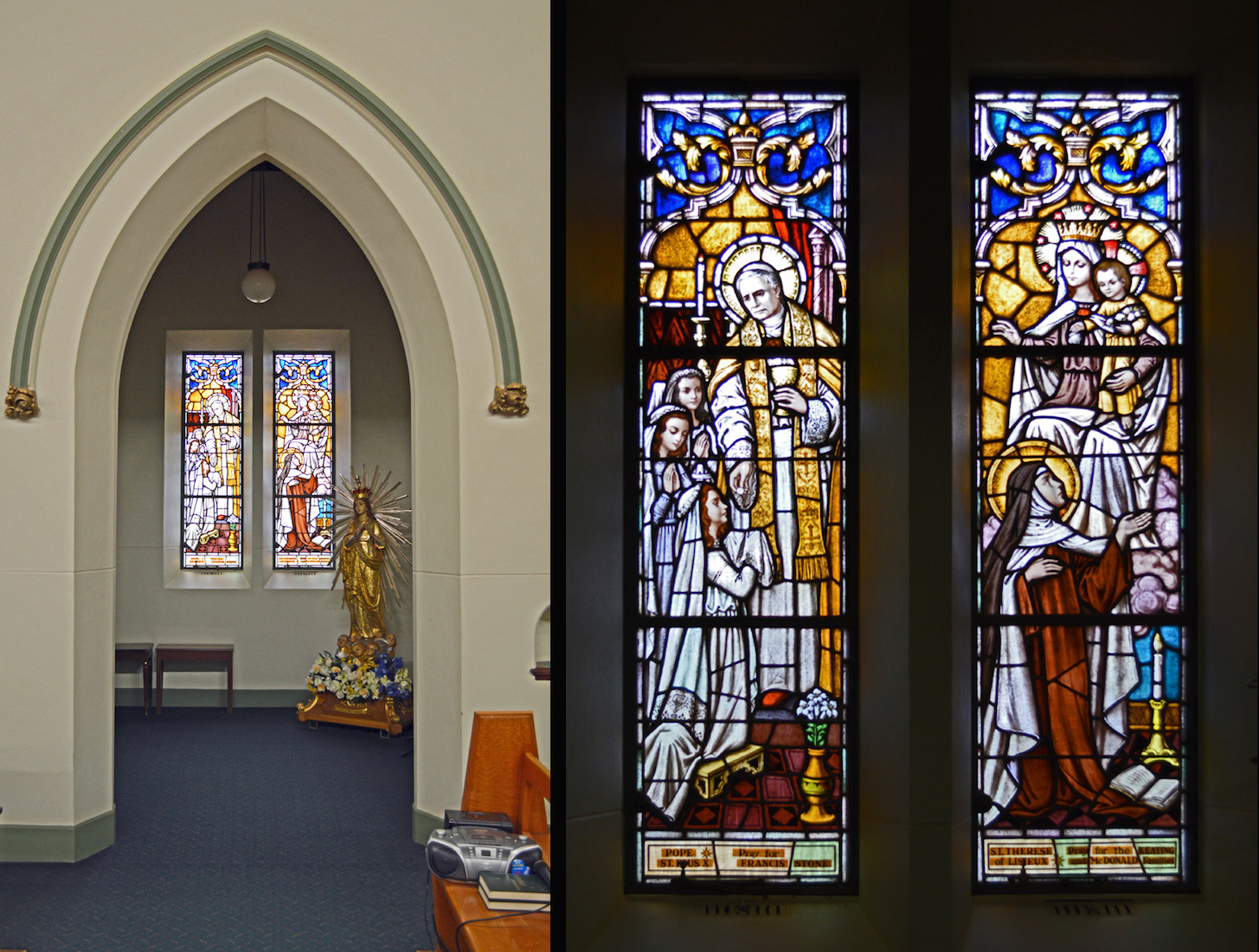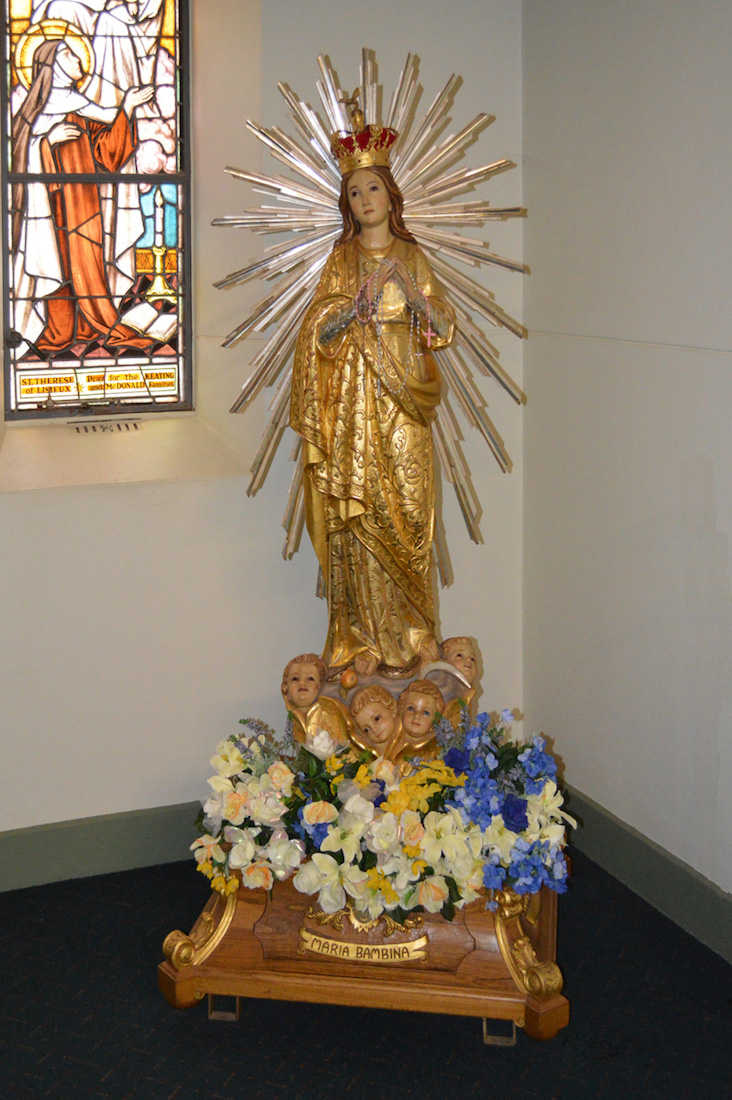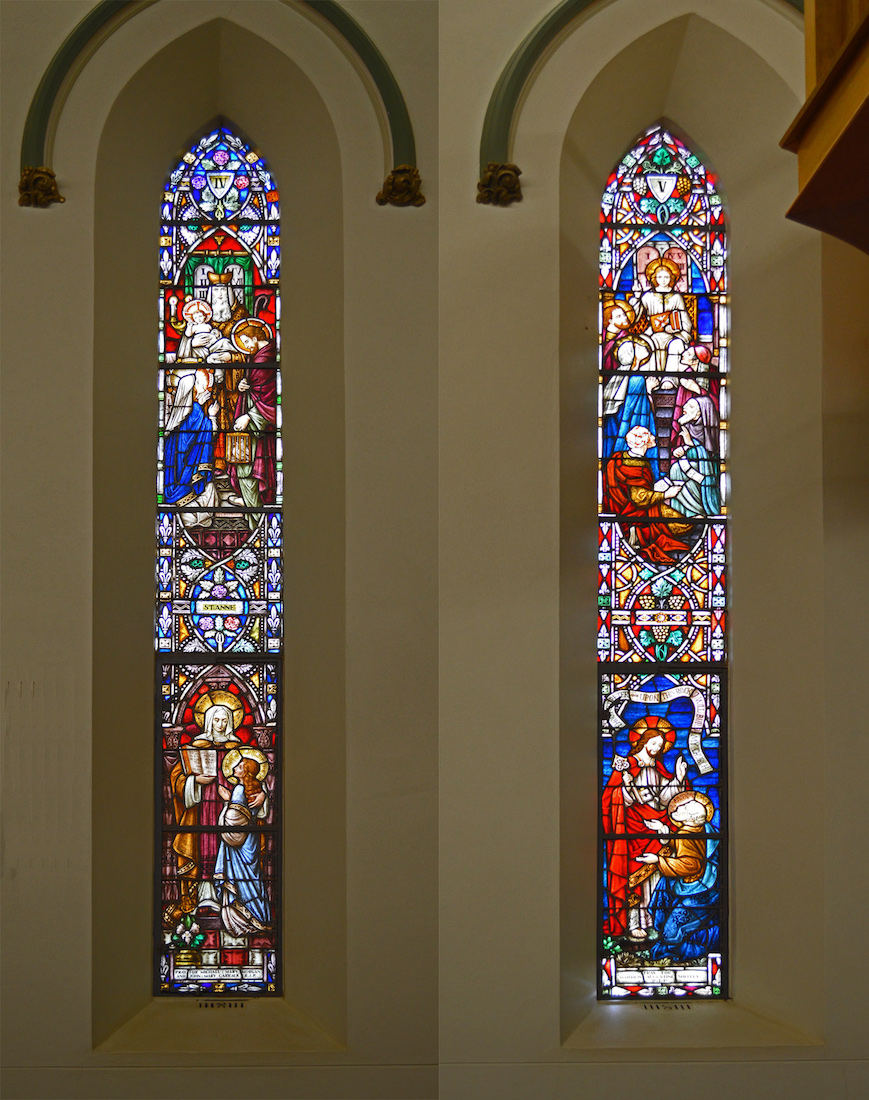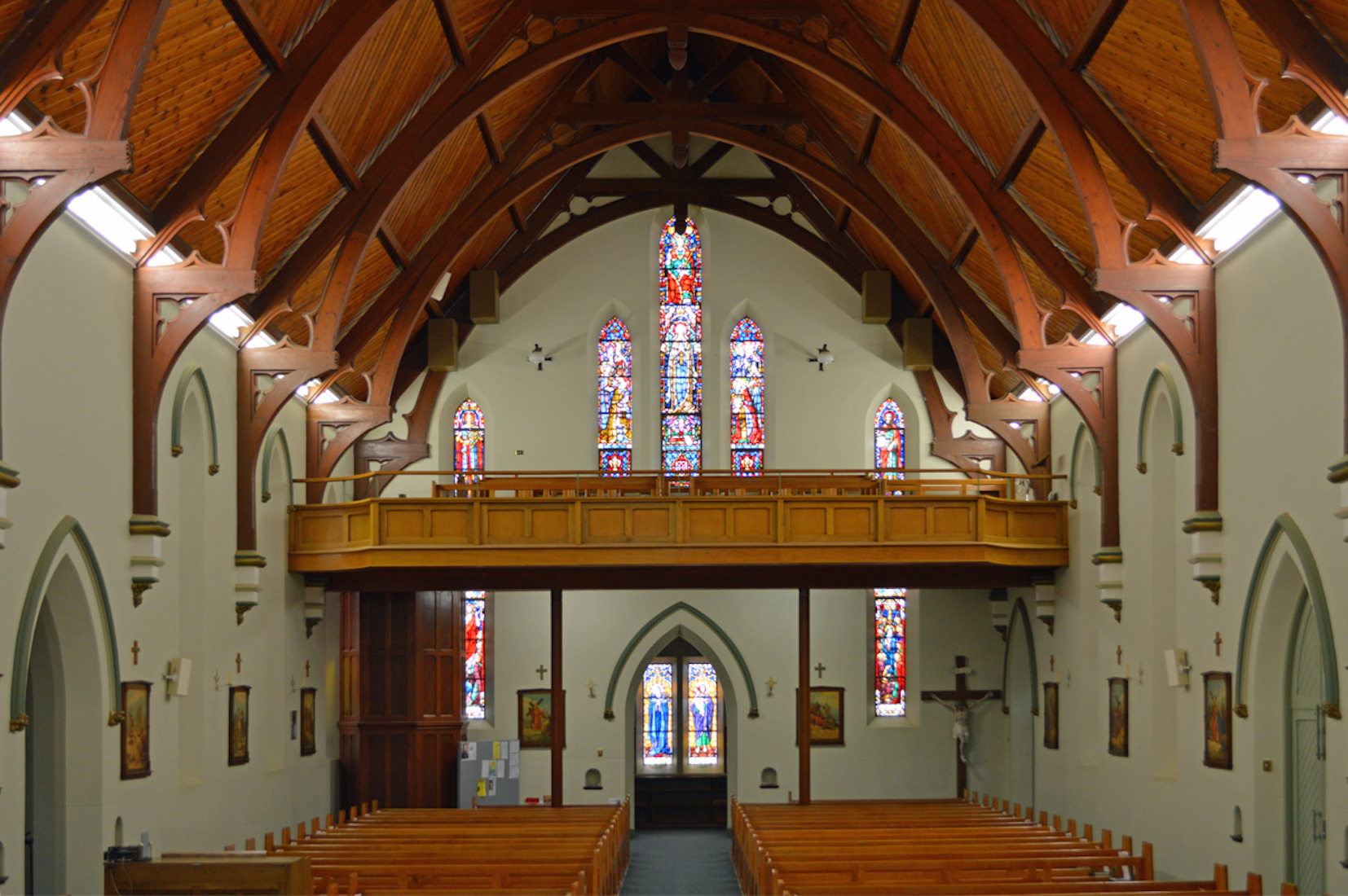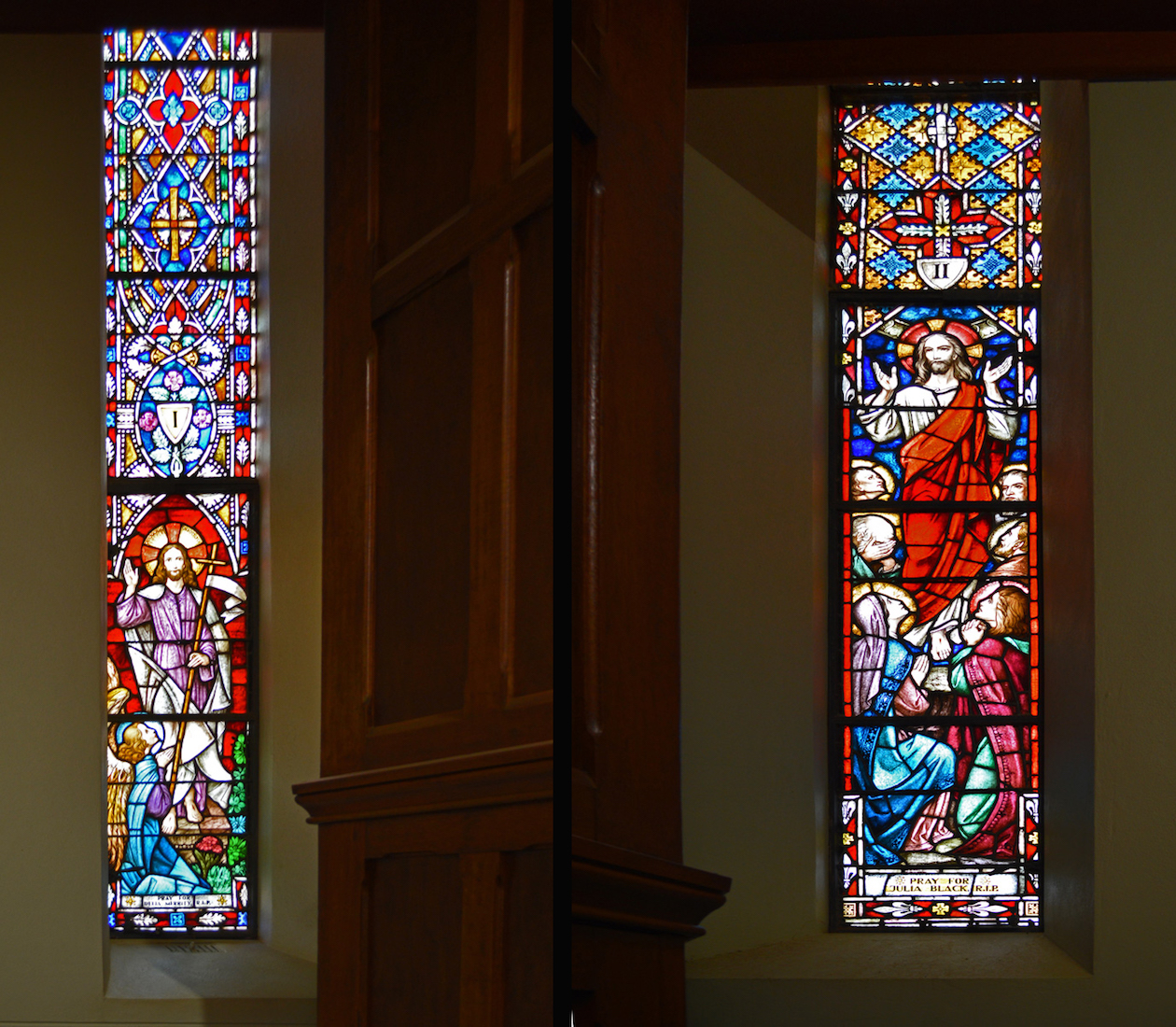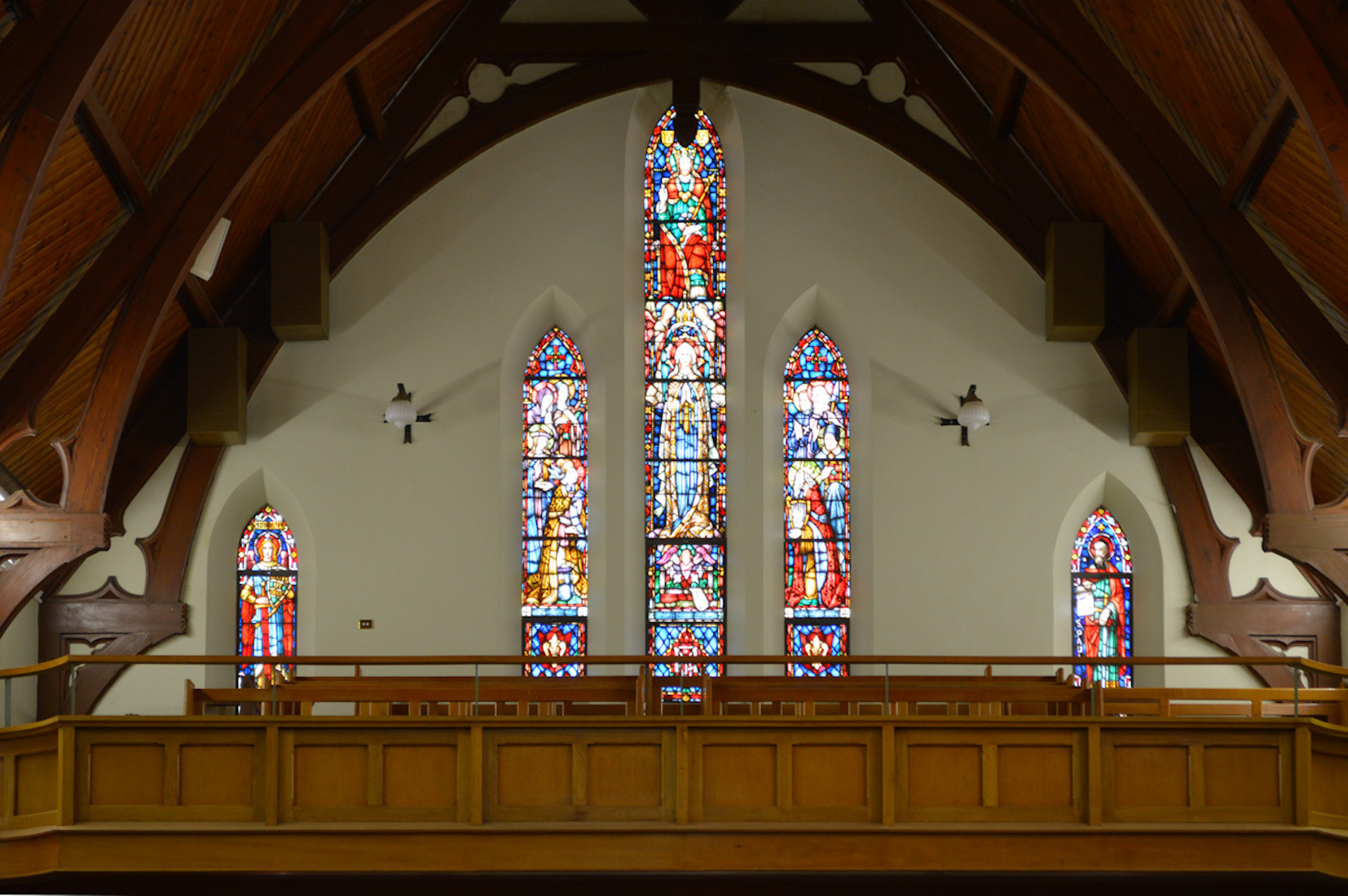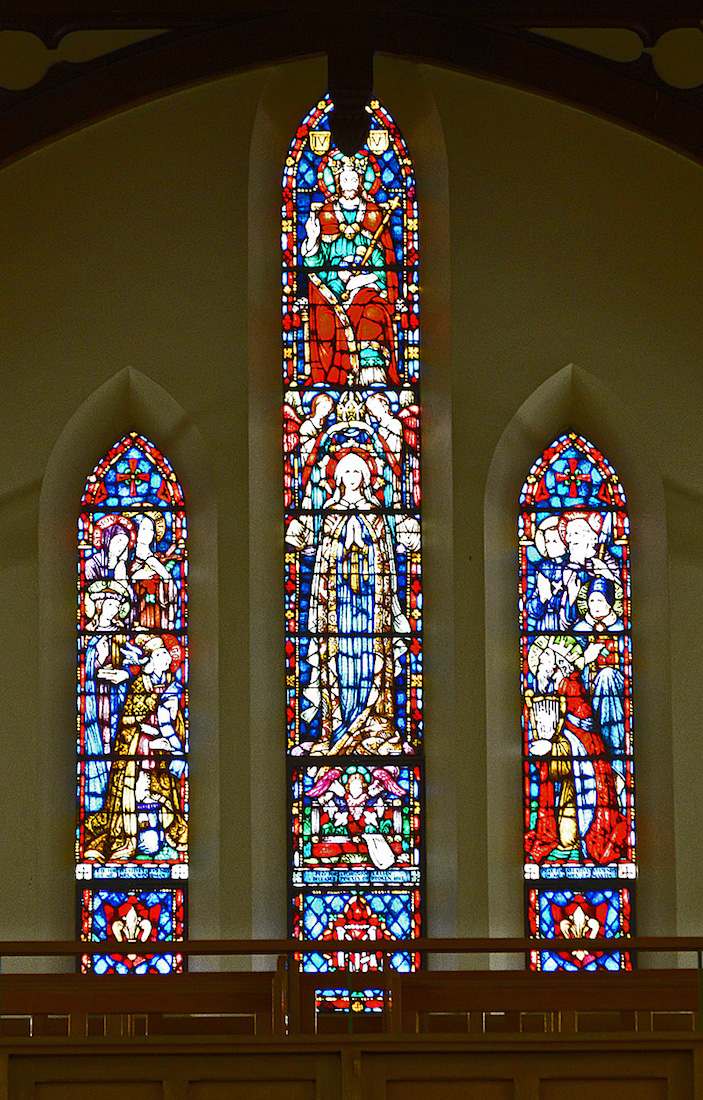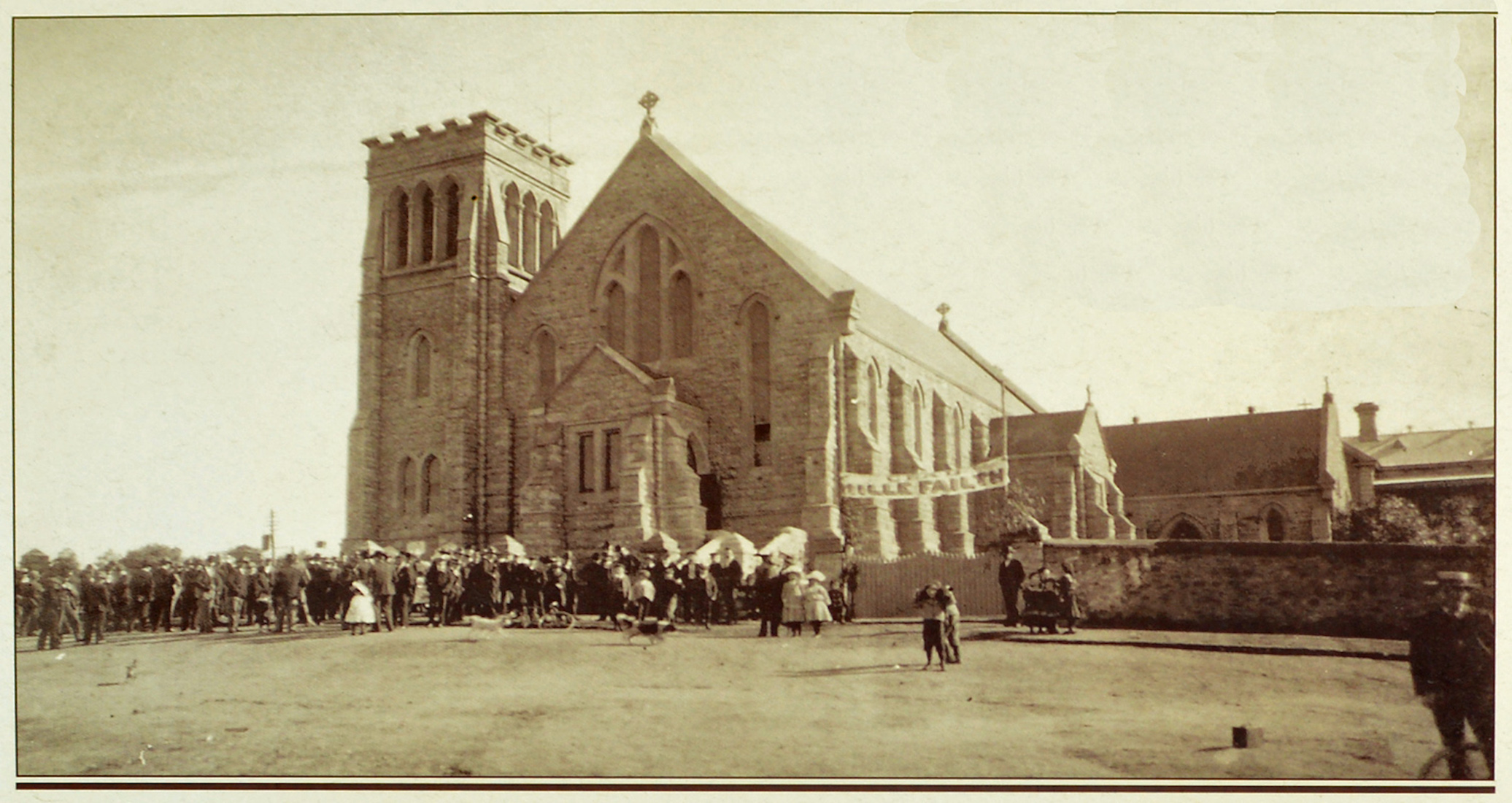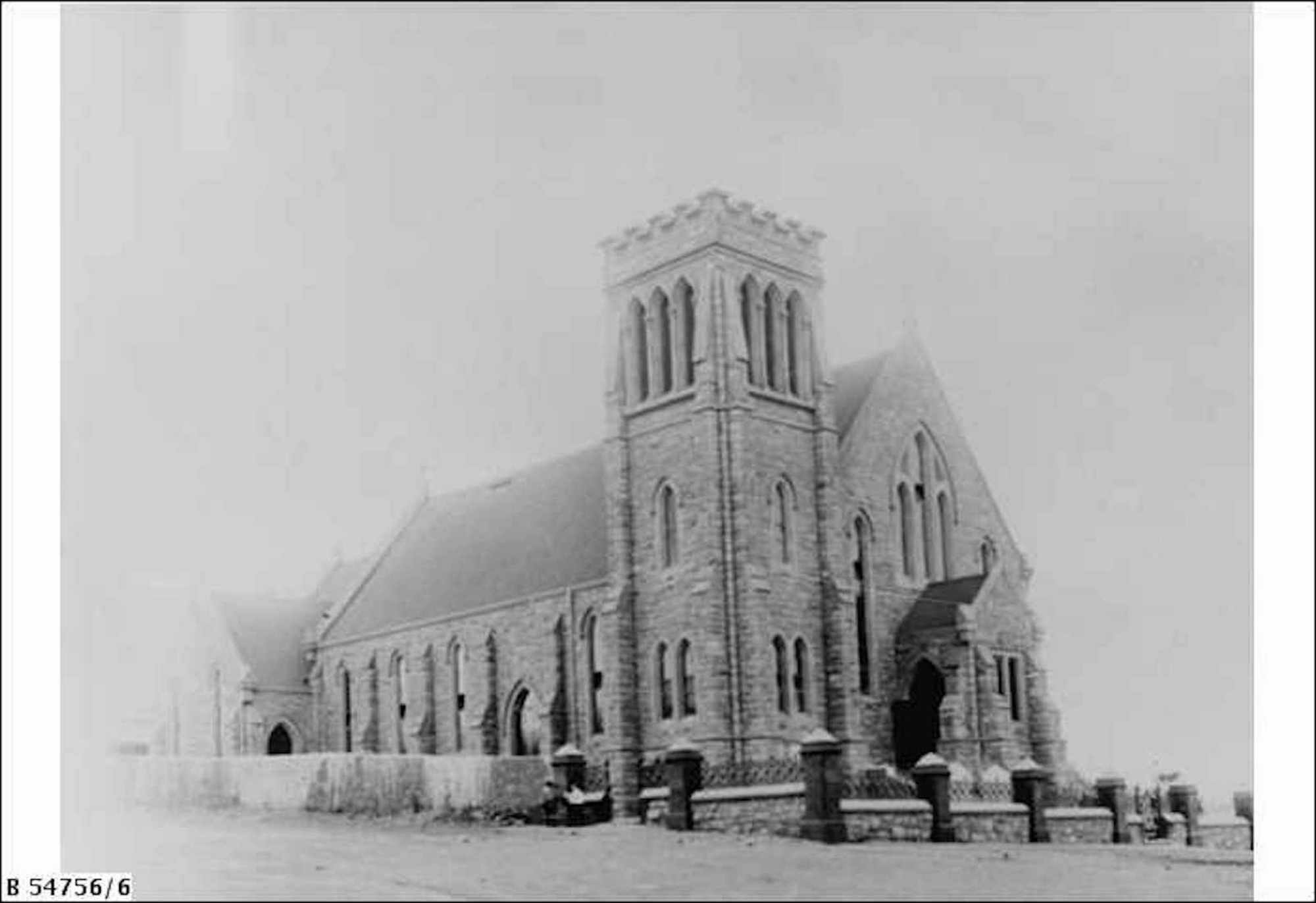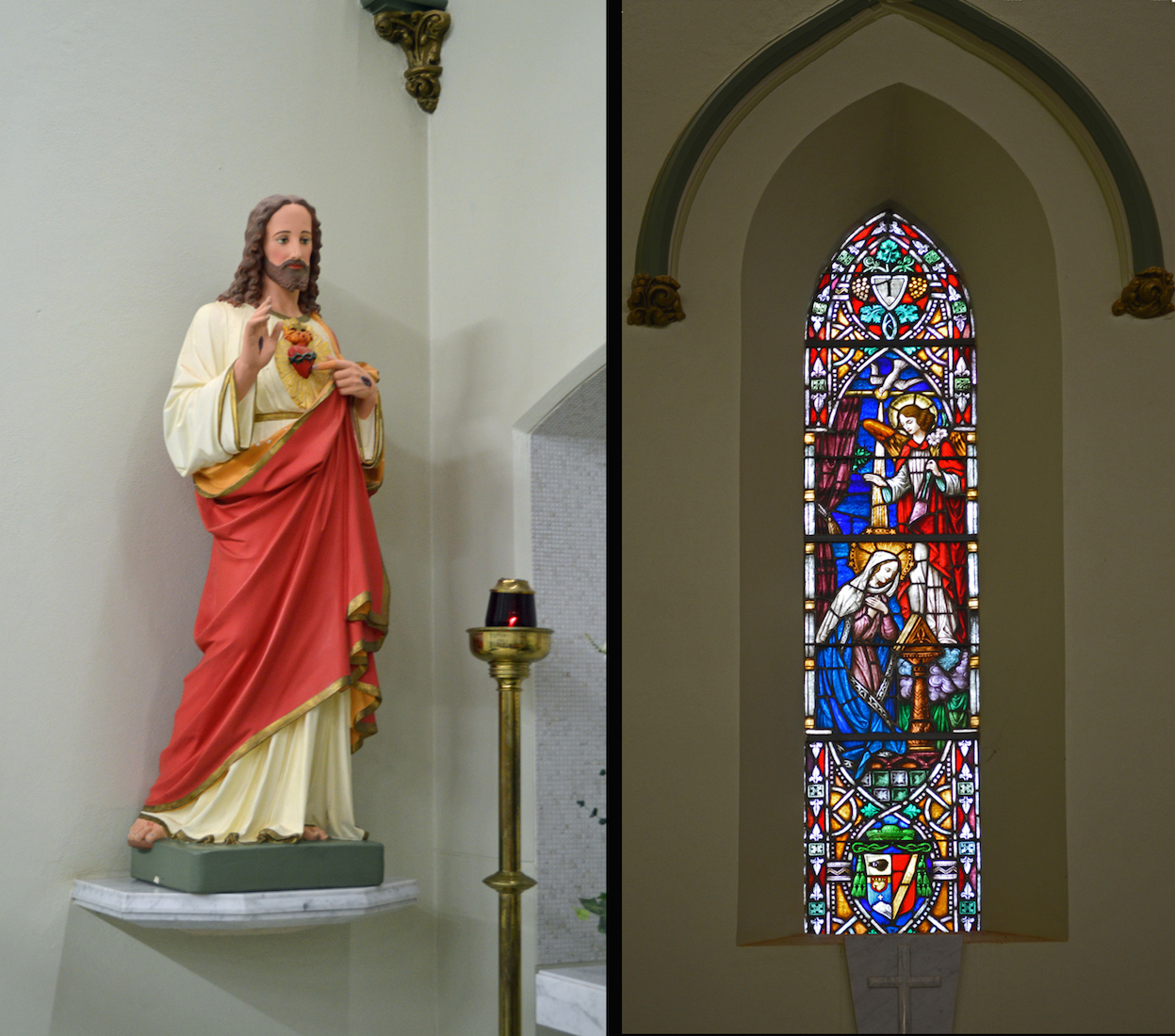
This statue of the Sacred Heart is found in many Catholic cathedrals. In the Roman Catholic tradition, the Sacred Heart has been closely associated with Acts of Reparation to Jesus Christ. Pope Pius XI has stated: ‘the spirit of expiation or reparation has always had the first and foremost place in the worship given to the Most Sacred Heart of Jesus’. The window above the altar depicts the Annunciation when the angel appeared to the Virgin Mary. This is the first of the Mysteries of the Rosary (notice the I at top). The windows in this set were installed during the Cathedral renovations of 1959 – 1960. INDEX
42. SACRED HEART MOSAIC
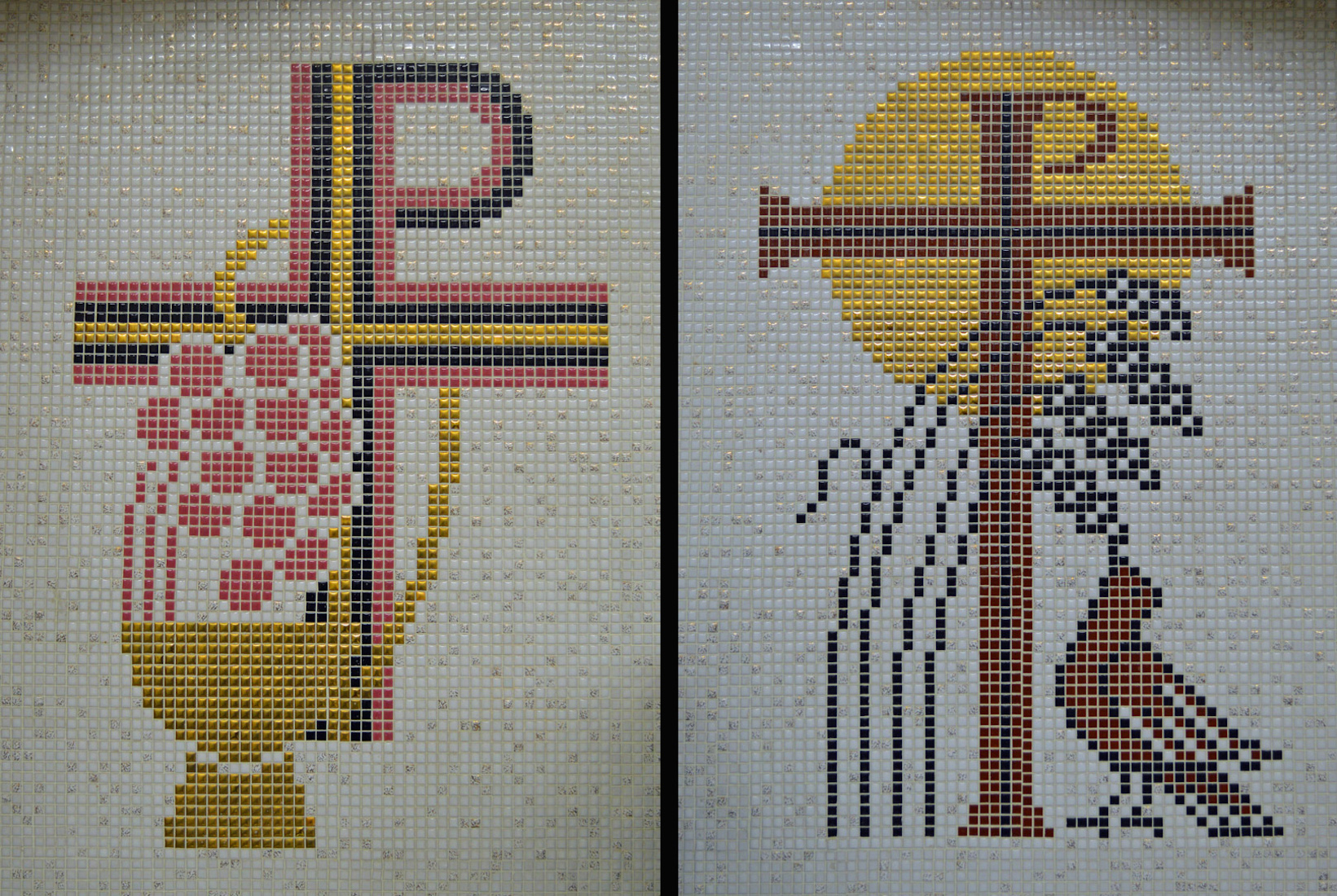
There are many historical instances where the Chi-Rho symbol has appeared in decorated form, sometimes with a basket denoting good works) or with a dove (denoting peace).
43. SOUTH NAVE WALL EAST
Standing near the Sacred Heart altar, we now look back along the South nave wall. The simple strip lighting in this Cathedral, installed in 1998, is unobtrusive and very effective.
44. SOUTH NAVE WINDOWS
The next two windows depict the second and third Joyful Mysteries of the Rosary: Mary’s Visitation to Elizabeth, and the Nativity. The inscription under the left scene reads: ‘Pray for Eugene Patrick & Mary Ann O’Neill RIP’, and under the right: ‘Pray for Gerald & Mary Fitzgerald RIP’.
45. ORGAN CONSOLE
A small electronic organ stands half way up the Nave on the South side. This appears to serve the musical needs of the Cathedral.
46. SIDE CHAPEL
Just out from the organ on the South side a small chapel extends. The statue of Mary carries the name ‘Maria Bambina’, and there is a pair of stained glass windows on the South wall. The window at left shows Pope St Pius X serving the Eucharistic wafer to a kneeling maiden. Inscription: ‘Pope St Pius X Pray for Francis Stone.’ The right window depicts St Therese of Lisieux praying to the Virgin Mary. Inscription: ‘Pray for the Keating & McDonald families.’
47. MARIA BAMBINA
The statue in the side chapel shows Mary wearing a crown standing in front of a burst of light. At her feet is an apple, a serpent and four babies. The plaque at the foot of the statue reads ‘Maria Bambina’. Statues of this form seem to appear more often under the title ‘Our Lady of Victories’, while the title ‘Maria Bambina’ usually refers to images of Mary as a baby.
48. SOUTH NAVE WINDOWS
Here are the next two windows on the nave South wall, West of the chapel. The left window is: IV Presentation of Our Lord, with a picture of the Virgin Mary and her mother St Ann below. Inscription: ‘Pray for Michael & Mary Morgan and John & Mary Carr RIP’. The right window shows: V Finding Jesus in the Temple at age 12, with Jesus and St Peter below. The scroll reads: ‘Thou art Peter and upon this rock I will build my church’. Inscription: ‘Pray for Matthew Augustine Shelley RIP’. The numbering corresponds to that of the Joyful Mysteries of the Rosary.
49. WEST WALL
We now take time to step into the nave to view the West wall. At centre are the three lancet windows which are the main feature of this wall. Our view of the two side windows is interrupted by the balcony built across in front. Notice the enclosed spiral staircase at left leading up to the balcony. There is a gleam of yellow light just to the left of this where another nave window is located.
50. SOUTH WEST NAVE WINDOWS
These two windows lie on either side of the balcony staircase. The numbers I and II refer to the Glorious Mysteries of the Rosary which are The Resurrection of Christ and The Ascension of Christ. The inscription for the left window is: ‘Pray for Della Merrity RIP’. The inscription for the right window is:‘Pray for Julia Black RIP’. The left window on the South wall of the nave continues up behind the balcony. The right window on the Western wall viewed here is just the bottom half of a much longer window, bisected by the balcony.
51. WEST WINDOWS
Here we have a closer view of the windows of the Western wall. Our view of each window is partially blocked by the balcony. In particular, we can only see the top portions of the outer windows.
52. SMALL WEST WINDOWS
Here is a view of what can be seen of the two outer windows. At left is St Michael, carrying sword and shield. On the shield are the words ‘QUIS UT DEUS’ which translates to ‘Who is like God?’ – the meaning of the name Michael. The idea that Michael was the advocate of the Jews became so prevalent that in spite of the rabbinical prohibition against appealing to angels as intermediaries between God and his people, Michael came to occupy a prominent place in the Jewish liturgy. At right we see the Apostle St Paul with his sword and scroll of the scriptures.
53. CENTRAL WEST WINDOW
The central window of the West wall comprises three lancet windows. The numbers IV and V from ‘The Glorious Mysteries of the Rosary’ indicate that the theme of these three lancets is The Assumption of Mary into Heaven, and, Mary is Crowned Queen of Heaven and Earth. The Assumption is a Catholic dogma dating from 1950, and the title of Queen for Mary dates from 1946. This completes our tour of Sacred Heart Cathedral.
54. 1905 OPENING
The first Catholic church in Broken Hill was an iron and timber structure erected in Mica St in 1887. In 1889, the Bishop of the Diocese of Wilcannia, Dr John Dunne, purchased the land on which the Cathedral now stands. In April 1903, the Bishop asked Mr W T Knox, an architect practising in Western NSW, to submit plans for the building of a new Cathedral. In October 1903, a tender for £5500 by Mr M K Power was accepted, and construction began soon after. On December 6 1903 the Bishop laid the foundation stone of the Cathedral, which was officially opened on 2 July, 1905. [Photo Credit : information plaque outside the Cathedral]
55. 1907 VIEW
Sacred Heart Cathedral, Broken Hill has been the cathedral of the diocese since 1905, though the bishops of Wilcannia had their residence in Broken Hill since 1889. The cathedral parish has some 5,500 parishioners, most of whom live in Broken Hill.
56. 1907 INTERIOR
In 1911, the original windows above the main altar in the Cathedral were removed and replaced with three stained glass windows. In 1941, a new Baptistry was erected in the southwest corner of the Cathedral beneath the bell tower. [Photo Credit : ca 1907 : slsa B54756_7]
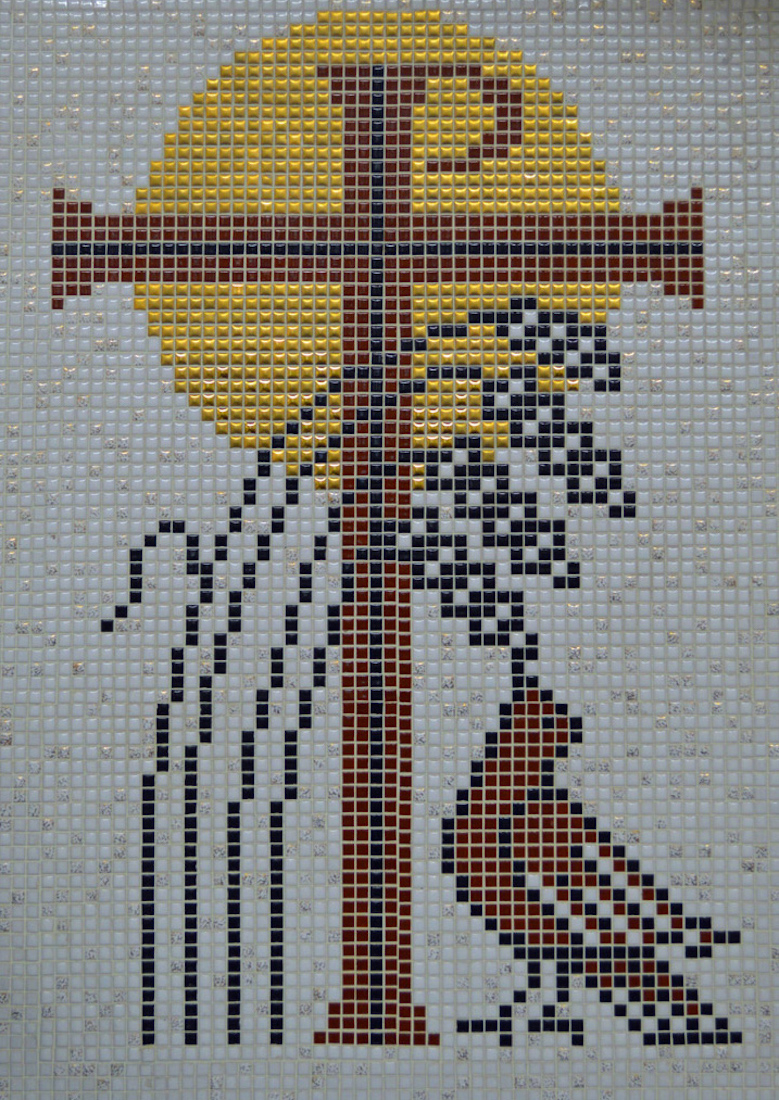
CONCLUSION
I hope you have enjoyed our tour of the Sacred Heart Cathedral, Broken Hill. Personally, I shall always remember this visit: I had an unexpected personal encounter with God here!
After completing a project like this, I am always conscious of things I have missed! So if you have some favourite photograph or extra information you would like to add here, I would be delighted to hear from you.
I am grateful to my wife Margie for some final proof-reading, but if there are any further typos, or factual errors, please feel free to contact me. The best websites are those which contain no errors!
A collection of my photos used on this site can be found at
https://www.flickr.com/photos/paulscottinfo/albums/
The Cathedral website has link:
https://www.wf.catholic.org.au/parishes/broken-hill/
Site created 09 / 2013; revised 01 / 2016 ; reformatted 08 / 2020
Paul Scott

